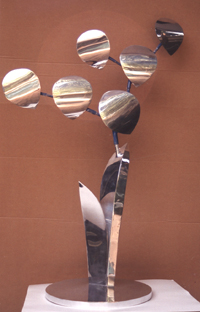Lin Emery’s Sculptures Sizzle with Kinetic Energy
by Chris Waddington, THE TIMES-PICAYUNE

Coryphee
An exhibit of Lin Emery’s sculpture is always a rare treat, and her latest work, at Arthur Roger Gallery, 432 Julia St., is no exception. The New Orleans-based artist has filled the gallery’s lofty front room with 16 signature pieces: spinning, dipping and swaying arrangements of polished aluminum that are just as graceful as their movements as in their metaphoric associations, evoking the corporeal pleasures of dance at one moment, at the next suggesting a fresh attempt to embody the spiritual in art.
If all this sounds a bit high-flown, be on notice: Her exhibit is one to which you can bring a 10-year-old child, an engineer or an art critic and expect smiles of delight.
Here visitors are invited to set works in motion, a pleasure most of us have been forced to defer when faced with Emery’s best-known local monument: the gleaming kinetic piece that rises from the reflecting pond in front of the New Orleans Museum of Art. But like that work – and the scores of monumental sculptures she has installed on sites as far flung as New York City, Singapore and Chicago – these smaller studio pieces reward sustained attention. Certainly it’s no small delight to determine how her mechanisms work, to observe how a force applied to one element gradually spreads through the whole piece, or simply to follow the unfolding changes of ever-graceful forms with the lazy eye of a cloud gazer.
For those interested in Emery’s methods, this exhibit is especially illuminating. Most of the pieces – which range from tiny tabletop objects to freestanding works that stand taller than most viewers – are models for larger creations. Thus by glancing across the gallery one can compare a working drawing, a tiny model and a three-quarter-size version of a proposed monument called “Analog.” If both models feel like autonomous works – not simply scaled-up versions of the same idea – it’s because Emery alters her designs at each stage, balancing elements visually and mechanically even as she considers the site requirements of the final work. And when her forms change, so do the movements of her works, giving each version a character as identifiable as the gait of an office colleague.
Emery’s insistence upon hands-on-control saves even her biggest pieces from the over-inflated stiffness of most public sculpture – works that are commonly completed by industrial fabricators.
Emery also knows how to shape pieces in the round, creating objects that hold one’s attention from all directions. To observe this quality, one need only to circle sculptures such as “Flourish,” or “Coryphee,” which rise from their bases and spread like well-trimmed ornamental plants. This organic quality recurs in most of her work, not simply because Emery has combined certain forms from nature – seeds, leaves and branching stems – but because those forms come together with the same sense of inevitability that one observes in time-lapse films of any natural process. Thus her pieces look fine at any point on stops them, but look even better in movement.
It’s an achievement that puts Emery in rare company. Among American sculptors only Alexander Calder, George Rickey and John Scott match her understanding of forms in motion. Interestingly, three of those artists have links to New Orleans, the only U.S. city in which sensuality is not considered taboo.
